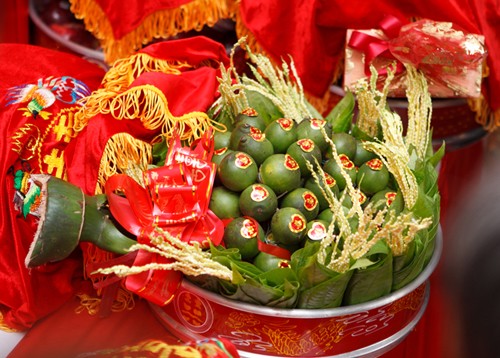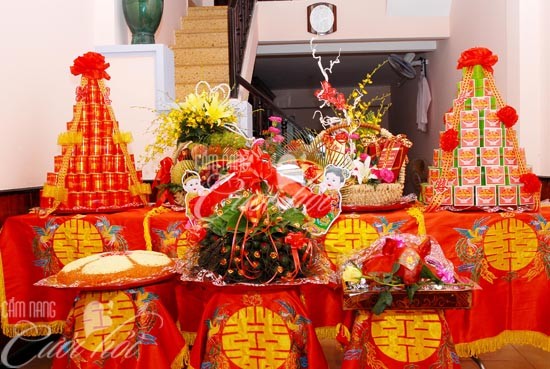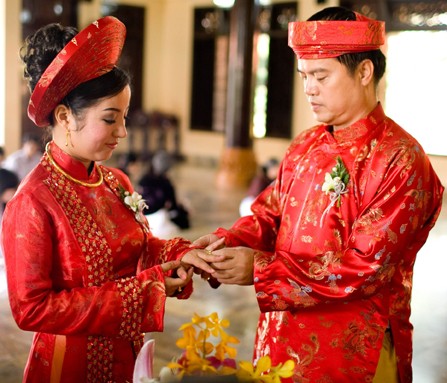Hello and welcome to VOV’s Letter Box, our weekly feature dedicated to listeners throughout the world. We are Mai Phuong and Ngoc Huyen.
A: On today’s program, we’d like to say hello to Steward Lessel, an American citizen living and working in Japan as an English teacher. Steward listened to our program on November 10 on the frequency of 12020 using a SONY ICF SW 7600 GR receiver. Steward, welcome to VOV. We hope you’ll keep tuning in to our broadcasts.
B: In his letters to VOV this week, Masaru Sekimoto reported listening to our programs on October 8 and November 13 on the frequency of 12020 with SINPO rated at 43443 and 34343. Masaru wrote: “I’m glad I caught your program. I have a good time listening to your program to learn about of Vietnam. I think Vietnam is interesting for everyone around the world. Vietnam is growing. I want to know many things about the culture of Vietnam. I will continue listening to your programs”.
A: Thank you, Masaru, for tuning in to VOV. We’ll send you a QSL card to confirm your report.
B: Next is an email from Mitul Kansal of India. This week, Mitul had a question about the first night tradition of a Vietnamese wedding.

Photo: internet |
A: Well, in Vietnam, we don’t have a tradition of celebrating the first night of a wedding. The traditional Vietnamese wedding is one of the most important ceremonies in Vietnamese culture with influence from Confucian and Buddhist ideologies. In Vietnam, as in many other countries, an engagement ceremony occurs from a week to half a year or so before the wedding. In the past, most marriages were arranged by the parents. The bride and groom met for the first time on the day of their engagement. However, in the last few decades, Vietnamese women and men have begun to choose their own marriage partners.
B: Preparations for a traditional Vietnamese wedding begin with choosing a date and time for the marriage ceremony. Vietnamese people often consult a fortune teller to choose the date and time of the wedding.
A: The wedding consists of a series of ceremonies, including asking the bride’s family’s elders’ permission to take the bride, and taking the bride from her house to the groom's house. Vietnamese, especially overseas Vietnamese, who want a hybrid traditional Vietnamese and Western-style wedding will often incorporate those two ceremonies with a Western-style exchanged vows. Following the ceremonies, there is a wedding reception for the two families and their guests.

Photo: internet |
B: All these proceedings might sound complicated to you. Let me elaborate further. Before the wedding day, or an hour before the wedding ceremony, the groom's family makes a trip to the bride's home with a tray of areca and betel nuts to officially ask for permission to receive the bride. At this time, the bride's family confirms the wedding and the groom may proceed.
A: On the day of the wedding, a procession of the groom's family goes in specific order. The first person is the chosen representative of the groom's family, followed by the groom's father, the groom, then the rest of his family and close friends.
B: In the past, the groom's mother might not take part in the procession to symbolize that she would not be a threat to the future bride. She might even "hide" for a short period when the bride is welcomed to the groom's home. However, this practice has been abandoned in some areas. The number of people participating in the groom's procession varies, but is usually restricted to 20 or so to make it easier on the bride's family, which must receive all the guests.
A: Upon arriving at the bride's home, the members of the procession are introduced to the bride's family. The groom presents his gifts to the bride's family, and he is given permission to greet the bride, who is finally brought out.
B: The permission ceremony begins in front of the bride's ancestral altar. The bride and groom burn incense sticks, asking for the ancestors to bless them. The couple turn and bow to their parents and thank the parents for raising and protecting them. The bride and groom then bow to each other.
A: The bride and groom, in front of all their guests, turn to their parents, and each parent gives the couple advice about marriage and family. Then the bride and groom exchange wedding rings, followed by a presentation of jewelry to the bride.

Photo: internet |
B: As the procession arrives back at the groom's house, the newlyweds are brought to the groom's ancestral altar, where another ceremony takes place and the bride is introduced to the groom's relatives. Finally, the bride is brought to the couple's room and shown the marriage bed. The wedding ceremony ends with a wedding feast enjoyed by both families.
A: Wedding traditions vary by region in Vietnam but we’ve outlined the most common proceedings of a Vietnamese wedding. We hope that Mitul Kansal and SB Sharma of India now have a clearer understanding of Vietnamese weddings. We’ll delve further into the wedding traditions of Vietnamese ethnic groups in later shows. So stay tuned.
B: Muhammad Shamim of India listened to our program on November 19 from 16:00 to 16:30 on the frequency of 7220 Khz with SINPO rated at 43434. Muhammad asked about the most popular English daily newspaper in Vietnam.
A: Well, I think it must be the Vietnam News, a publication of the Vietnam News Agency. When Viet Nam News first hit the news stands in 1991, it was a modest four-page newspaper whose stories were written, edited and proofed by hand. Since then, Vietnam’s major English language daily has published seven days a week. It now has 28 pages a day, providing comprehensive coverage of the latest domestic and international developments in politics, economics, business, social affairs and sport. Special pages carry commentary, analysis, and reports on the environment, science and technology, lifestyle, and key social issues.
B: This week, we received an email from Pablo Lopez of Spain, who wrote in Spanish. We managed to get it translated into English, but next time, Pablo, could you please write to us in English. By the way, thank you for your New Year greetings.
A: On today’s program, we’d like to acknowledge letters and emails from Fumito Hokamura of Japan, and Siddhartha Bhattachajee and Baikan Hazarika of India. Thank you all for your reception reports. We’ll send you QSL cards and the souvenirs you requested soon.
B: We welcome your feedback at: English section, Overseas Service, Radio Voice of Vietnam, 45 Ba Trieu Street, Hanoi, Vietnam. Or you can email us at: englishsection@vov.org.vn. You’re invited to visit us online at www.vovworld.vn, where you can hear both live and recorded programs. Good bye until next time.